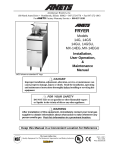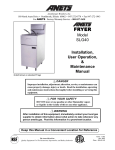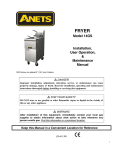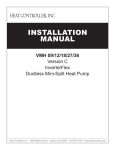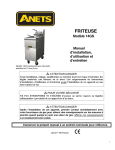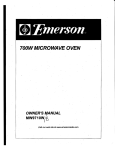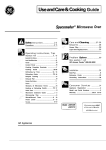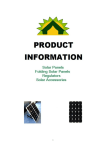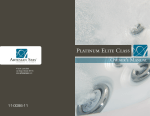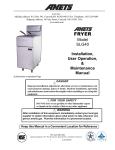Download Anets MX-14E Specifications
Transcript
Anets Inc. Mailing Address: P.O. Box 501, Concord,NH 03302-0501 USA Telephone: 603-225-6684 Shipping Address: 10 Ferry Street, Concord, NH 03301 USA www.anets.com FRYER Models 14G, 14GS 14GU, 14GSU, MX-14EG, MX-14EGU Installation, User Operation, & Maintenance Manual 14GS shown on standard 6” legs ! DANGER Improper installation, adjustment, alteration, service, or maintenance can cause property damage, injury or death. Read the installation, operating and maintenance instructions thoroughly before installing or servicing this equipment. ! FOR YOUR SAFETY DO NOT store or use gasoline or other flammable vapors or liquids in the vicinity of this or any other appliance. ! WARNING After installation of this equipment, immediately contact your local gas supplier to obtain information about what action to take whenever any person smells gas. Post this information in a prominent location. Keep this Manual in a Convenient Location for Reference The Anets Golden Line Quality Equipment For The Restaurant, Supermarket, and Bakery Industries L20-362 rev 3 1 ! DANGER Read these specifications, Code Requirements, Installation Requirements, Installation Instructions, and Operating Instructions very carefully. Failure to follow the Instructions could cause the fryer to malfunction. A fryer malfunction can result in property damage, serious bodily injury, or death. CONTENTS Shipping Container Inspection ........................................................ Fryer Gas Supply Specifications ..................................................... Fryer Electrical Specifications ....................................................... Figure 1 - Fryer Model 14GS Wiring Diagram ....................... Code Requirements ...................................................................... 3 4 4 4 5 Figure 2 - Fryer Site Installation Requirements ....................... 6 Installation Requirements ............................................................... 6 Installation Instructions .................................................................. 7 Leg Installation Instructions ..................................................... 7 Leg Leveling Instructions ......................................................... 7 Figure 3 - Typical Leg Installation ......................................... 7 Caster Installation Instructions ................................................. 8 Figure 4 - Typical Caster Installation ..................................... 8 Caster Leveling Instructions .................................................... 8 Fryer Restraining Device Installation Instructions ....................... 9 Gas Connection Instructions ........................................................ 10 Fryer Operating Instructions ........................................................ 11 Fryer Preparation For Use (“Boil Out” Instructions) .............. 12 Figure 5 - Draining The Kettle ............................................. 12 Lighting Procedure ................................................................ 13 Figure 6 - Gas Safety Valve & Control Knob Positions ........ 13 Shutdown Procedure ............................................................ 14 Food Product Frying Time Chart............................................ 15 Daily Cleaning Procedure ....................................................... 16 Monthly Maintenance Instructions .......................................... 17 Fryer Troubleshooting Guide ................................................. 18 - 22 Fryer Warranty ............................................................................ 23 2 SHlPPlNG CONTAlNER lNSPECTlON 1. Carefully examine the shipping carton for external damage. When damage is noted, notify the delivery carrier immediately. Save all packing materials for damage claim examination. 2. If no external damage is noted, remove the shipping carton from the fryer and examine the fryer carefully for damage. Place the fryer in a safe location, if damage is noted, so that the freight damage claims adjuster can examine the fryer. 3. Save the shipping container for use during leg/ caster installation. Refer to the Installation Instructions for that procedure. Models Covered By This Manual Model Features Model 14G 14GU Plain Steel Fryer Kettle Plain Steel Fryer Kettle, CE version 14GS 14GSU Stainless Steel Fryer Kettle Stainless Steel Fryer Kettle, CE version MX-14EG MX-14EGU Features High Efficiency Fryer High Efficiency Fryer, CE version Standard Accessories furnished in the shipping carton for this fryer include: 2 Fryer Baskets 4 Adjustable Legs 1 Drain Valve Extension 1 Cleanout Rod 1 Screen 1 Basket Hanger Other optional equipment includes a sediment tray; single or triple baskets; a built-in Filtronic™ II or Filter Mate under-fryer filter system; a fryer cover; a drain table; a front drain tray; or four casters. Note: A Parts List for each Anets fryer is among th eitems shipped with each fryer. If an additional copy of this list is needed please contact the factory as directed on the back cover. 3 FRYER GAS SUPPLY SPEClFlCATlONS Please make sure that Vour desired frVer location has gas supplV factors that are suitable for this product: INPUT REQUIRED: Natural Gas Propane MANIFOLD PRESSURE 3½“ W.C. ** 10“ W.C. SUPPLY PRESSURE*** 6“ W.C., minimum 111,000 BTU* 11“ W.C., minimum * - BTU/Hr Rating is based on sea level operation. For sites above 2000 feet, reduce this rating 4% for each 1000 feet above sea level. ** - “W.C. = Inches, Water Column. *** - Measure Supply Pressure when all other gas-powered equipment is operating. Gas Supply Inlet Pipe size must be ¾“ NPT (National Pipe Thread) standard gas line. The gas supply inlet line should be as straight as possible (fewest bends or elbows) to obtain the highest available gas pressure at the fryer. Locate this inlet line horizontally at the center of the desired fryer location, 8¼“ above the floor. NOTE: Using a flexible inlet line permits variation in the gas supply line location, both horizontally and vertically. Anets fryers are only for use with the type of gas specified on the spec plate. if a fryer requires modification to use a gas other than that which is identified on the fryer spec plate, contact you Anets representative or call 1-603-225-6684. FRYER ELECTRlCAL SPEClFlCATlONS The ANETS Fryer Models 14GS, 14GSU, MX-14EG, and MX-14EGU require no exter-nal electric power source. Figure 1 is a wiring diagram of an ANETS 14GS Fryer. Some fryers may have other options that do not appear in this basic wiring diagram. A model-specific wiring diagram included with each fryer shows all the actual parts and their associated wiring connections. In addition, a fryer equipped with a builtin filter sys- tem (Filtronic II or Filter Mate) has a supplementary manual included for that option. Figure 1. Fryer Model 14GS Wiring Diagram 4 CODE REQUlREMENTS lMPORTANT: Read the Code Requirements and ALL installation instructions carefully, before starting the installation. Contact the factory if any problems or questions arise. The fryer installation must conform with local codes, or in the absence of local codes, with the National Fuel Gas Code, ANSI Z223.1 (latest edition); the Natural Gas Installation Code, CAN/ CGA-B149.1 (latest edition); or the Propane Gas Installation Code, CAN/CGA-B149.2 (latest edition), as applicable, including: a. Disconnect the fryer and its individual shutoff valve from the gas supply piping system during any pressure testing of the gas supply system at test pressures in excess of ½ psig (3.45 kPa). b. Isolate the fryer from the gas supply piping system during any pressure testing of the gas supply system at test pressures equal to or less than ½ psig (3.45 kPa). c. For fryers utilizing floor casters, the fryer installation shall comprise a connector that complies with the Standard for Connectors for Movable Gas Appliances, ANSI Z21.69 (latest edition) or CAN/CGA 6.16 (latest edition), and a quick-disconnect device that complies with the Standard for Quick-Disconnect Devices for Use with Gas Fuel, ANSI Z21.41 or CAN/CGA 1-6.9 (latest edition). d. Restrict the movement of a caster-equipped fryer by using a limiting device (for example, a cable attached both to the fryer and to a fixture attached to the site structure) to avoid depending on the connector and the quick-disconnect device or its associated piping to limit fryer movement. e. Install this fryer on a non-combustible floor with its back and sides at least 6” away from any combustible wall, as shown in Figure 2. ! WARNlNG Install this fryer under a ventilation hood that conducts combustion products outside the building. Venting must comply with ANSI/NFPA 96 (latest edition). f. Install this fryer in a location where adequate combustion and ventilation air is available. Keep the area directly in front of the fryer open for adequate air flow to the burners. DO NOT obstruct the flow of combustion and ventilation air. g. Keep the fryer area free and clear from combustibles and debris. h. Attach a restraining device to each fryer, to prevent the unit from tipping, which could cause splashing of hot liquid. From the top of the flue on the fryer, allow a minimum of at least 10 inches vertical clearance beneath a ventilating hood. Figure 2. Fryer Site Installation Requirements lNSTALLATlON REQUlREMENTS Install the fryer in accordance with the preceding Code Requirements, as well as the following Installation Requirements. 1. DO NOT install this fryer in a mobile home, trailer, or recreational vehicle. 2. Install this fryer in a location that allows it to be moved away from other adjacent appliances for cleaning and maintenance. NOTE: If the fryer is installed among a row of appliances (“banked”) where its only convenient movement is forward, sufficient room must be available in front to permit its separation from adjacent appliances for cleaning and maintenance. 3. Tightly fasten the legs (or casters) to the bot- 6 tom of the fryer using the supplied hardware, to prevent the fryer from tipping, wobbling or rocking when it is in its desired location. Refer to the following Installation Instructions for leg or caster attachment and leveling information. ! CAUTlON: Hood make-up air MUST NOT flow in a manner that restricts or impedes the natural flow of combustion or ventilation air. 4. Confirm that the air from the ventilation hood flowing near the fryer after installation is NOT blowing on the rear of the fryer, to prevent affecting the burner flames and possibly causing control damage. lNSTALLATlON lNSTRUCTlONS LEG INSTALLATION INSTRUCTIONS 1. Flatten the shipping carton (after unpacking the fryer and its parts and accessories) for surface protection during leg installation. LEG INSTALLATION INSTRUCTIONS (Continued) 7. Tighten the four locking nuts evenly and securely to hold the leg mounting plate against the fryer mounting bracket. 2. Position the side of the fryer flat on the carton, exposing the fryer bottom mounting brackets for leg installation, as shown in Figure 3. 3. Place the leg mounting plate flush against the mounting bracket on the fryer bottom. 4. Insert one mounting bolt through a flat washer and then through the proper hole in the fryer mounting bracket and through the leg mounting plate. 5. Screw a locking nut several turns onto the mounting bolt. 6. Repeat steps 4 and 5 until all four mounting bolts for a leg are in place with locking nuts. Figure 3. Typical Leg Installation LEG LEVELING INSTRUCTIONS 1. Move the fryer to its desired location. ! WARNlNG The fryer MUST NOT tip, rock or wobble, to avoid splashing or spilling its HOT frying fat contents during operation. 2. Turn the screw-type leg adjustment ends as necessary to level the fryer, until no tipping, rocking, or wobbling is evident. 3. Perform the “Fryer Restraining Device Installation Instructions.” 7 lNSTALLATlON lNSTRUCTlONS (Continued) CASTER INSTALLATION INSTRUCTIONS 1. Flatten the shipping carton (after unpacking the fryer and its parts and accessories) for surface protection during leg installation. 2. Position the side of the fryer flat on the carton, exposing the fryer bottom mounting brackets for caster installation, as shown in Figure 4. 3. Place the caster mounting plate flush against the mounting bracket on the fryer bottom. 4. Insert one mounting bolt through a flatwasher (supplied) and the caster mounting plate, then through the proper hole in the fryer bottom mounting bracket. 5. Screw a locking nut several turns onto the mounting bolt. 6. Repeat steps 4 and 5 until all four mounting bolts for a caster are in place with locking nuts. 7. Tighten the four bolts evenly and securely to hold the caster mounting plate against the fryer mounting bracket. Figure 4. Typical Caster Installation CASTER LEVELING INSTRUCTIONS 1. Move the fryer to its desired location. 2. Determine whether the fryer tends to wobble or rock when in its desired location. If it does not, perform step 10, then proceed to the Fryer Operating Instructions. If it does, perform steps 3 through 9. ! WARNlNG The fryer MUST NOT tip, rock or wobble, to avoid splashing or spilling its HOT shortening contents during operation. 3. Determine which caster requires adjustment and the approximate amount of change required to level the fryer. 4. Position the rear side of the fryer on the shipping carton, exposing the bottom of the fryer with the caster mounting plates (Figure 4). 8 lNSTALLATlON lNSTRUCTlONS CASTER LEVELING INSTRUCTIONS (Continued) 5. Completely unscrew the bolts holding the caster mounting plate that requires leveling adjustment. Retain the locking nuts for later reassembly. 6. Reinsert each bolt through its flatwasher and the fryer mounting bracket; next, place a spacer of the required thickness on the bolt before inserting the bolt through its mounting hole on the caster mounting plate and screwing a locking nut onto the bolt. (Continued) CASTER LEVELING INSTRUCTIONS (Continued) 8. Tighten all four locking nuts evenly and securely against the caster mounting plate and the fryer bottom mounting bracket. 9. Return the fryer to its desired location and check again for wobbling or rocking. Repeat steps 3 through 8 until no wobbling or rocking occurs. When the fryer no longer wobbles or rocks, perform step 10. 10. Next, perform the “Fryer Restraining Device Installation Instructions.” 7. Repeat step 6 for all remaining bolts. FRYER RESTRAINING DEVICE INSTALLATION INSTRUCTIONS ! WARNlNG Fryers MUST have a movementlimiting (restraining cable) device installed to prevent tipping that causes splashing or spilling of its HOT contents. NOTE: This movement-limiting device is to be furnished and installed by the fryer’s installing contractor before the fryer is connected to the gas line at its desired location. 1. Install one restraining device connector into the structure wall directly behind the fryer’s desired location, as shown in Figure 2. 2. Install one restraining device connector on the rear panel of the fryer very close to the quickdisconnect device on the end of the fryer’s gas line. 3. Attach one end of the restraining cable to the wall connector. Attach the other end to the fryer connector. 4. Confirm that the fryer cannot move far enough away from the wall to cause excessive movement of the flexible gas line or its associated connectors. 9 GAS CONNECTlON lNSTRUCTlONS Installing your ANETS Fryer requires the following procedure, after its legs or casters are properly attached and it is in its desired location. 1. Ensure that the gas control valve knob in the fryer has its OFF position next to the valve mark. 2. Ensure that the gas supply inlet line valve is closed (cross-wise to the pipe line direction). 3. Ensure that all fryer controls are set to OFF. 4. Connect the ¾” gas supply line to the gas line adapter on the lower rear of the fryer. 10 ! WARNlNG DO NOT use a flame to check for leaks. 5. Turn the gas supply line valve ON; then, confirm that all gas supply line joints and couplings are free of leaks, using soap suds or a leakcheck solution, after the fryer is in its desired location. 6. Refer to Fryer Operating Instructions to begin using your ANETS Fryer. FRYER OPERATlNG lNSRUCTlONS ! CAUTlON DO NOT attempt to operate this fryer during a interruption of gas service. Turn all fryer controls to OFF, including the gas control valve knob, then close the gas supply line valve. When notified that the gas interruption has ended, perform the Lighting Procedure (later in this manual). ! DANGER NEVER operate this fryer when its flue is blocked or when the ventilation hood is not on because the combustion products can cause injury to personnel. ! DANGER Avoid moving the fryer while it contains HOT shortening. Drain the shortening from the fryer before moving it for service, cleaning or maintenance to avoid spilling or splashing. Burns from hot shortening can cause serious injury or death. A. An ANETS Fryer is designed for operation with a kettle filled with approximately 35 to 50 pounds (or 3½ to 6 gallons) of liquid shortening. CAUTION: DO NOT melt solid ! shortening in this fryer because the melting can damage the kettle, which will void the fryer warranty. Solid shortening must be melted into the liquid state before it can be used in an ANETS Fryer. B. Schedule regular cleaning of the fryer to ensure long-term satisfactory operation. Refer to the Daily Cleaning Procedure, later in this manual. C. Before servicing and maintenance, allow the fryer to cool. ALWAYS shut off the gas to the fryer while working on it, to prevent burns. D. Contact the factory 1-603-225-6684 for warranty service authorization. [Always notify the factory the next business day about ‘after-hours’ warranty service.] Contact your local restaurant equipment service agency for other service, repairs, or maintenance activities, as necessary. E. When breaded food products are being cooked, ANETS recommends using the special (optional) sediment tray tocapture any breading fragments that become loosened from the food product. Periodic clearing of the sediment tray reduces premature contamination of the liquid shortening from breading fragments. 11 FRYER OPERATlNG lNSTRUCTlONS FRYER PREPARATION FOR USE “BOIL OUT” INSTRUCTIONS New ANETS Fryers are leak-tested and cleaned at the factory before shipping. Before using a newly installed fryer for food preparation, clean the kettle again, as follows: 1. Thoroughly wipe the interior of the kettle with clean cloths. Open the front door on the lower portion of the fryer to access the drain ball valve. Open the drain ball valve (by aligning the valve handle with the drain ball valve) and wipe the entire drain line clean. 2. Close the drain ball valve (turn the valve handle cross-wise to the drain ball valve). Fill the kettle with water to about 3“ from the top. Add 1 to 2 cups of soap powder, washing soda (trisodium phosphate), or deep fat fryer kettle cleaner. (Continued) FRYER PREPARATION FOR USE (Continued) ! CAUTION For fryers with built-in filter systems, DO NOT pump the cleaning, or rinsing, solution through the filter system, to avoid damaging the filter system pump. 7. Open the front door and mount the drain extension to the drain ball valve. Position a container (bucket) capable of holding VERY HOT cleaning solution beneath the end of the drain extension to hold the cleaning solution being drained, as shown in Figure 5. 3. Perform the Lighting Procedure for the fryer. (Refer to the Lighting Procedure later in this manual.) 4. Set the thermostat to 190°F. Heat, but DO NOT boil the water. Stir the water to dissolve the cleaning material. ! WARNlNG Hot cleaning solution can cause severe burns. Take care when handling hot cleaning solution to avoid spilling or splashing the solution. 5. Clean the fryer kettle for at least 20 minutes. Use a small hand mop (an optional brush can be ordered for this purpose) to clean the upper portion of the kettle (above the 3“ waterline) and the top rim of the kettle. 6. Shut down the fryer using the Shutdown Procedure for the fryer. (Refer to the Shutdown Procedure later in this manual.) Allow the water to cool slightly. Figure 5. Draining The Kettle 8. Open the drain ball valve SLOWLY, to avoid splashes while draining the cleaning solution from the kettle. 9. Close the drain ball valve (valve handle crosswise) and remove the drain extension. Close the front door. 10. Safely dispose of the cleaning solution. 11. Fill the kettle with water to about 3“ from the top. Add 2 cups of vinegar to neutralize the cleaning solution. 12. Repeat steps 3 through 10 of this procedure. 13. Thoroughly wipe the interior of the kettle and the drain ball valve with clean, dry, wiping cloths to remove ALL water. 14. Dry the kettle thoroughly because any remaining water can cause sputtering of hot shortening when the kettle is later filled and heated. 12 FRYER OPERATlNG lNSTRUCTlONS (Continued) Normal operation of an ANETS Fryer requires that the kettle is filled with liquid shortening above the lower indent level, marked on the rear of the kettle, before lighting the fryer’s pilot and turning on the main burner. ! CAUTION: Shortening MUST be in liquid form to avoid scorching or discoloration and possible damage to the kettle. Damage caused by melting solid shortening will NOT be covered by the warranty. LIGHTING PROCEDURE NOTE: The gas line of a new fryer installation may contain a considerable amount of air that will hinder immediate lighting. You may have to press in the gas safety valve control knob as long as several minutes before the pilot flame burns steadily. 1. Ensure that the fryer’s thermostat knob is set to OFF. 2. Open the gas supply line inlet valve to the fryer by aligning the gas valve handle with the gas line piping. ! CAUTION: Ensure that both pilot viewing/lighting ports are closed, to prevent excessive heat from damaging the gas controls. 8. Turn the gas control valve knob to align the ON setting with the valve mark. 9. Turn the thermostat knob to the desired temperature. Observe that the fryer’s main burners light to heat the kettle. 3. Open the front door and move the right pilot viewing/lighting port cover aside. 4. Turn the gas control valve knob to align the PILOT setting with the valve mark. Figure 6 shows the possible gas control valve knob positions. 5. Press, and hold down, the valve control knob to allow pilot gas to flow. Model 14G, 14GU, 14GS, or 14GSU: Use a match or lighter to ignite the pilot burner. Model MX-14EG or MX-14EGU: Push the spark igniter pushbutton several times, until the pilot flame lights. (A match may also be used to light the pilot flame.) Continue holding down the control knob for at least 30 seconds until the pilot flame burns steadily without going out. 6. Release the control valve knob and observe that the pilot flame remains lighted. Close the right pilot viewing/lighting port. 7. Light the left pilot flame by opening the left pilot viewing/lighting port and applying a match to ignite the pilot flame. Close the left pilot viewing/lighting port. European Valve Markings Valve Mark OFF OFF ON OFF PILOT ON PILOT ON Figure 6. Gas Control Valve & Knob Positions 13 FRYER OPERATlNG lNSTRUCTlONS (Continued) SHUTDOWN PROCEDURE NOTE: Shutdown is recommended at the end of a workday or whenever no frying is required for a period of several hours. The fryer should be shutdown during any power outage or interruption of gas service. The fryer MUST also be shutdown before draining the kettle, or whenever there is no shortening in the kettle to prevent damage. 1. Turn the thermostat knob to OFF. 2. Turn the gas control valve knob to align the PILOT setting with the valve mark. 14 3. Open the pilot viewing/lighting port to confirm that only the pilot flame remains lighted. 4. Press down and turn the gas control valve knob to align the OFF setting with the valve mark. Observe that the pilot flame goes out. NOTE: For extended periods of non-use or when servicing the fryer, close the gas supply line inlet valve to the fryer by turning the gas valve handle cross-wise with the gas linepiping. FRYER OPERATlNG lNSTRUCTlONS (Continued) RECOMMENDED FRYlNG TlME FOR POPULAR FRlED FOODS Load the fryer basket with the food product while the basket is not in the hot liquid shortening. DO NOT overload the fryer basket. Load only a premeasured quantity of food product (1½ lb, typically; less, if smaller portions are desired). Place the loaded fryer basket into the hot liquid shorteningcarefully to avoid splashing. ANETS Fryer (° F) Food Product (Typical 1½ lb load) Breaded Foods Calamari Cheese Sticks Fresh Shrimp (Breaded) Frozen Shrimp (Breaded) Mushrooms Onion Rings Tamale Sticks 340 Frying Time (minutes) 2½ - 3 3 3 4 2½ - 3 2½ - 3 3 When the basket of food product has reached the desired point of ‘doneness’, lift the basket from the hot shortening and hang the basket on the basket hanger to let it drain for approximately 15 30 seconds before serving. Chicken Croquettes (Nuggets) Pre-cooked, Breaded Pieces Raw to Done, Pieces* Tenders NEVER increase the thermostat setting above the recommended setting to reduce the cooking time; this will produce a lower quality product and will cause more rapid shortening breakdown. French Fries Raw to Done Blanched, only Browned, only 1/4” cut 1/4” cut 1/4” cut 5 2½ 2½ Raw to Done Blanched, only Browned, only 3/8” cut 3/8” cut 3/8” cut 6 3 3 Raw to Done Blanched, only Browned, only 1/2” cut 1/2” cut 1/2” cut 7 4 3 3- 4 3-4 12 - 15 5 3½ Corn Dogs Fritters 3 Frozen Fish Tortilla Chips** 4-7 340 2 - 2½ * - Usual per order = Wing, Leg, Breast, Thigh (1/2 chicken) ** - Use a second basket on top of the chips in the bottom basket, to keep them within the hot shortening; otherwise, they float before cooking completely. 15 FRYER OPERATlNG lNSTRUCTlONS DAILY CLEANING PROCEDURE DAILY CLEANING PROCEDURE NOTE: Cleaning is recommended at the end of a workday, to prepare the fryer for proper operation the next time it is to be used. (Continued) 5. Allow the shortening to cool before draining. Slowly open the drain ball valve to drain the shortening. Take care to avoid spilling or splashing the shortening. ! DANGER DO NOT move the fryer while it contains HOT shortening. Allow it to cool and drain the shortening from the fryer before moving it for service, cleaning, or maintenance to avoid spilling or splashing. [Refer to steps 1 through 7.] Burns from HOT shortening can cause serious injury or death. When cleaning, if relocation of your fryer is necessary, disconnect the gas supply line to the fryer. Also, if your fryer is caster-equipped, unlock the locking casters and disconnect the movementlimiting cable. Move the fryer as necessary to allow the following cleaning procedure to occur: 6. Carefully use the Cleanout Rod to clear any sediment blocking the kettle drain. Flush out all sediment in the bottom of the kettle by pouring filtered, liquid shortening into the kettle until the shortening being drained runs clear. 7. Close the drain ball valve, after the kettle is completely empty of shortening and sediment. Detach the drain extension. Clean, rinse, and dry it before storing. ! WARNlNG Wait until the kettle has cooled before performing step 8, to avoid injury from burns. 1. Open the front door of the fryer. Attach the drain extension to the drain ball valve. 8. Thoroughly wipe the kettle interior using clean cloths. 2. Perform the Shutdown Procedure. Ensure that the gas supply line inlet valve is closed (handle cross-wise to pipe line) and the pilot flame is extinguished. 9. Periodically perform the “BOIL OUT” Instructions to ensure thorough cleaning of the kettle. ( Refer to the earlier FRYER PREPARATION FOR USE section.) 3. Position a steel drum [NEVER use plastic!] with a filter cone, directly beneath the drain extension end, OR if your fryer is equipped with an ANETS Filtronic ™II or Filter Mate unit, refer to that equipment’s manual for operation details. 4. Remove the fryer baskets and the sediment tray, if present, from the kettle. (If the screen is present, use the cleanout rod to lift it from the hot shortening, to avoid burns.) Thoroughly clean, and rinse, these items in the sink. MAKE SURE that these items are completely dry before their next use. 16 (Continued) 10. Return the fryer to its normal operating location and reconnect both the gas supply line and the movement-limiting cable. (For caster-equipped fryers, lock the locking casters to prevent movement.) 11. Refill the kettle with filtered (or fresh) liquid shortening to the desired indent mark on the rear wall of the kettle, only if fryer operation is to continue during a subsequent shift. Otherwise, melt shortening into its liquid state and refill the kettle before fryer operation is scheduled during the next working shift. FRYER OPERATlNG lNSTRUCTlONS (Continued) DAILY CLEANING PROCEDURE (Continued) 12. Return the screen (or, if used, the sediment tray) to its proper position in the kettle. Place the fryer baskets on the basket hanger, ready for use. 13. Perform the Lighting Procedure to return the fryer to operation, when desired. MONTHLY MAINTENANCE INSTRUCTIONS NOTE: Regular maintenance is recommended to keep the fryer operating properly. Once each month, before beginning fryer operation, check the flue (behind the backsplash panel) to ensure that it is clear, enabling exhaust combustion gases to flow freely toward the ventilation hood area. DO NOT allow the flue to become excessively dirty. NEVER allow the flue to be blocked. Monthly, observe the condition of the ventilation hood. If it shows evidence of a great deal of greasy residue, remove (clean) the residue to allow free flow of ventilation air. 17 FRYER TROUBLESHOOTlNG GUlDE All service (repairs or part replacement) must be performed by a qualified Service Agency. PROBLEM Pilot (piezo-electric) pushbutton igniter, if present, does not light the pilot flame Pilot flame does not stay lighted. 18 CAUSE REMEDY 1. Electrode of igniter out of position or dirty/sooty electrode. 1. Move electrode within 3/16” of pilot burner tip. Clean the electrode. 2. Loose spark wire; loose igniter nut. 2. Check spark wire connection at the igniter nut and make sure the connection is tight. 3. Piezo-electric igniter does not generate a spark. 3. Replace igniter mechanism (portion with pushbutton). 1. Dirty/sooty pilot burner. 1. Clean the pilot burner. Perform the Lighting Procedure. 2. Low gas supply pressure [less than 6” W.C. for natural gas; (11” W.C. for propane) when all other gas-powered equipment is operating]. 2. Measure the gas supply pressure. Contact your local gas supplier to obtain adequate gas supply pressure. 3. Pilot flame too small to heat the thermocouple. 3. Adjust the pilot valve (part of the gas control valve) to increase the flame size: Unscrew and retain the slotted threaded cover; turn the pilot valve adjustment screw two turns counterclockwise; reinstall the threaded cover. 4. Pilot flame ‘wavering’ (being blown about by a draft). 4. Block or redirect the draft, to keep the flame burning steadily. 5. Improper thermocouple output voltage (must be at least 10 millivolts, measured at the thermocouple junction block). 5. Replace the thermocouple. 6. High-limit thermostat problem has shut off the gas. 6. Check for, and repair, any damaged high-limit thermostat wiring. [For model 14GSU fryer ONLY: Press the reset pushbutton on the high-limit thermostat control. Perform the Lighting Procedure, to check whether the pilot flame lights. If the pilot flame stays lit, the highlimit thermostat has failed and must be replaced. ] FRYER TROUBLESHOOTlNG GUlDE PROBLEM CAUSE Pilot flame does not 6. High-limit thermostat problem has shut off stay lighted. (Continued) the gas. (Continued) (Continued) REMEDY 6. (Continued) For model 14GS, MX-14EG, and MX14-EGU fryers ONLY: Test the high-limit thermostat by disconnecting the thermocouple at the gas control valve. Then, disconnect the red wires to the high-limit thermostat from the gas control valve. Reconnect the thermocouple; next, perform the Lighting Procedure, to check whether the pilot flame lights. If the pilot flame stays lit, the high-limit thermostat has failed and must be replaced. ! CAUTION: DO NOT return the fryer to normal operation with its high-limit thermostat bypassed/disconnected. Pilot flame goes out repeatedly. 7. Gas control valve has failed. 7. Replace the gas control valve. 1. Low gas supply pressure [less than 6” W.C. for natural gas; (11” W.C. for propane) when all other gas-powered kitchen equipment is operating]. 1. Measure the gas supply pressure. Contact your local gas supplier to obtain adequate gas supply pressure. 2. Loose thermocouple or high-limit thermostat connection(s) on gas control valve. 2. Check and tighten the connections. 3. Pilot flame does not continuously touch the thermocouple because of excessive air flow around the pilot burner assembly. 3. Block the excessive air flow to make the pilot flame contact the thermocouple. 4. High-limit thermostat problem has shut off the gas. 4. Check for, and repair, any damaged high-limit thermostat wiring. [For model 14GSU fryer ONLY: Press the reset pushbutton on the high-limit thermostat control. Perform the Lighting Procedure, to check whether the pilot flame lights. If the pilot flame stays lit, the highlimit thermostat has failed and must be replaced. ] 19 FRYER TROUBLESHOOTlNG GUlDE PROBLEM Pilot flame goes out repeatedly. (Continued) CAUSE 4. High-limit thermostat problem has shut off the gas. (Continued) (Continued) REMEDY 4. (Continued) For model 14GS, MX-14EG, and MX14-EGU fryers ONLY: Test the high-limit thermostat by disconnecting the thermocouple at the gas control valve. Then, disconnect the red wires to the high-limit thermostat from the gas control valve. Reconnect the thermocouple; next, perform the Lighting Procedure, to check whether the pilot flame lights. If the pilot flame stays lit, the high-limit thermostat has failed and must be replaced. ! CAUTION: DO NOT return the fryer to normal operation with its high-limit thermostat bypassed/disconnected. Main burners do not ignite. 20 1. Gas control valve knob set to OFF or PILOT. 1. Perform the normal Lighting Procedure. Turn the gas control valveknob to ON to light the main burners. If the burners do not light, the gas control valve has failed and must be replaced. 2. Low gas supply pressure [less than 6” W.C. for natural gas; (11” W.C. for propane) when all other gas-powered kitchen equipment is operating]. 2. Measure the gas supply pressure. Contact your local gas supplier to obtain adequate gas supply pressure. 3. Pilot burner problem. 3. Refer to the preceding Pilot Burner problems and use the correct remedy. 4. Thermostat control set below the temperature of the liquid shortening in the kettle. 4. Increase the thermostat setting until the burners light. If this setting is greater than the desired temperature, reset the thermostat to the desired setting and allow the shortening to cool to the desired temperature. 5. Gas control valve has failed. 5. Replace the gas control valve. FRYER TROUBLESHOOTlNG GUlDE PROBLEM Main burners do not stop burning. Liquid shortening does not reach the desired temperature for frying. CAUSE (Continued) REMEDY 1. Thermostat has failed. 1. Turn the thermostat control knob to OFF. If the burners do not quit burning, the thermostat has failed and must be replaced. 2. Gas control valve has failed. 2. Turn the gas control valve knob to OFF. If the burners do not quit burning, the gas control valve has failed and must be replaced. 1. Low gas supply pressure [less than 6” W.C. for natural gas; (11” W.C. for propane) when all other gas-powered equipment is operating], causing reduced heat from main burners. 1. Measure the gas supply pressure. Contact your local gas supplier to obtain adequate gas supply pressure. 2. Low gas manifold pressure [less than 3½” 2. Measure the gas pressure at the fryer’s manifold pressure tap. W.C. for natural gas; (10” W.C. for proAdjust the manifold pres-sure pane). (see Figure 6), as neces-sary: [a] Unscrew (and re-tain) the threaded Main Burner Regulator Adjustment Cover. [b] Use a flat-blade screwdriver to turn the regulator adjustment screw (clockwise to increase; counterclockwise to decrease) to reset the pressure adjustment. [c] Reinstall, and tighten, the Regulator Adjustment Cover, when finished. 3. Loose knob on thermostat; or thermostat requires calibration (temperature setting differs by about 10°F from measured shortening temperature). 3. Stir the shortening to mix the hot shortening with some from the lower ‘cool zone’ and allow it to sit for 5 minutes. Turn the thermostat knob until it ‘clicks’ on (causing the main burners to flame); note the setting where this occurs. Turn the thermostat knob until it ‘clicks’ off (causing the main burners to go out); note the setting where this occurs. Repeat this temperature ‘click points’ step at least three times to ensure that 21 FRYER TROUBLESHOOTlNG GUlDE (Continued) PROBLEM CAUSE REMEDY Liquid shortening does not reach the desired temperature for frying. 3. Loose knob on thermostat; or thermostat requires calibration (temperature setting differs by about 10°F from measured shortening temperature). (Continued) 3. (Continued) the shortening temperature has stabilized. Measure the temperature of the shortening by inserting an accurate thermometer about 4 inches into the shortening to measure its temperature. If the temperature difference between the measured temperature and the thermostat setting is 10°F or less, the thermostat can be recalibrated. Recalibrate the thermostat by: (a) removing the cap on the thermostat control knob; (b) loosening the center brass hex nut portion of the knob; (c) turn the pointer portion of the knob to the measured temperature value of the thermostat setting. Tighten the brass hex nut to lock the adjustment. Replace the cap on the knob. (Continued) 4. Thermostat setting is more than 20°F dif- 4. Check the thermostat setting against an accurate measure of ferent than measured shortening temperathe shortening temperature. If ture. the temperature difference is greater than 20°F, the thermostat can possibly be recalibrated. Recalibrate the thermostat by: (a) removing the cap on the thermostat control knob; (b) loosening the center brass hex nut portion of the knob; (c) turn the pointer portion of the knob to the measured temperature. Tighten the brass hex nut to lock the adjustment. Replace the cap on the knob. If this calibration is unsuccessful, the thermostat has failed and must be replaced. 22 ORIGINAL EQUIPMENT LIMITED WARRANTY General Warranty Anets, Inc. warrants to the original user of its commercial cooking appliances and related equipment that said appliances and related equipment will be free from defects in material and workmanship under normal use for a period of one (1) year from the date of installation, with appropriate documentation, to a maximum of fifteen (15) months from the date of manufacture, subject to the following additions, exceptions, exclusions and limitations. What is covered This warranty is limited to the repair or replacement at the Company’s option, without charge, of any part found to be defective within the warranty period and reasonable expenses incurred for freight and material for the installation of such part; in addition, the Company’s obligation shall be limited to reimbursement for normal labor on such parts. Anets, Inc. agrees to pay the Authorized Service and Parts Distributor, for any labor and material required to repair or replace, at the Company’s option, any part which may fail due to defects in material or workmanship during the above general warranty period. Silver Line Fryers In addition to the above general warranty, for its economy fryers and cookers, the Company warrants to the original user any mild. Stainless steel fry tank or cooking vessel to be free from defects for a period of one (1) year, from the date of manufacture. Labor and freight shall be the responsibility of the end user. Gold Line Fryers In addition to the above general warranty, for its standard fryers and cookers, the Company warrants to the original user any stainless steel fry tank or cooking vessel to be free from defects for a period of (1) year parts and labor and 10 year Frypot or cooking vessel Part only from the date of manufacture Labor and freight shall be the responsibility of the end user. Pasta Cooker In addition to the above general warranty, for its standard fryers and cookers, the Company warrants to the original user any stainless steel fry tank or cooking vessel to be free from defects for a period of one (1) year parts and labor and 5 years Frypot or cooking vessel part only after year one from the date of manufacture. Labor and freight shall be the responsibility of the end user. Limitations to Fry Tank and Cooking Vessel Warranty After the expiration of the general warranty period, any additional warranty on fry tanks or cooking vessels shall only obligate the Company to repair or replace, at its option, any fry tank or cooking vessel which it determines to be defective. Claims under this item shall be supported by a statement detailing the defect, and the Company may require the return of the fry tank or cooking vessel claimed to be defective. Labor and freight shall be the responsibility of the end user. How to Keep Your Warranty in Force • • • • • Make sure any shipping damages are reported immediately. Damages of this nature are the responsibility of the carrier and must be reported by the receiver. Install the unit properly. This is the responsibility of the installer and the procedures are outlined in the manual. Do not install it in a home or residence. Maintain it properly. This is the responsibility of the user of the appliance and the procedures are outlined in the manual. Adjustments, such as calibration, leveling, tightening of fasteners or plumbing or electrical connections normally associated with initial installation. These procedures are outlined in the manual and are NOT covered by warranty. If it is damaged due to flood, fire or other acts of God, this is not covered under this warranty. • •Use it for what it is intended. If it is used for a purpose other than for which it was intended or designed, resulting damages are not covered under the warranty. • Make sure that it has the correct voltage, gas supply and/or good quality water. If a failure is due to poor water quality, harsh chemical action, erratic voltage or gas supplies, these damages are not covered under the warranty. • Do not materially alter or modify from the condition in which it left the factory. Do not obliterate, remove or alter the serial number rating plate. • • Use only Genuine OEM parts from Anets, Inc. or its Authorized Parts and Service Distributors. Repairs are not covered by the warranty. If any other failure occurs which is not attributable to a defect in materials or workmanship, it is not covered. • This warranty specifically excludes parts which wear or would be replaced under normal usage, including, but not limited to, electric lamps, fuses, interior or exterior finishes, o-rings and gaskets. Limits to the Warranty Outside the United States of America and Canada, this warranty is limited to the replacement of parts and Anets, Inc. will not bear any other expense be it labor, mileage, freight or travel. If any oral statements have been made regarding the appliance, these statements do not constitute warranties and are not part of the contract of sale. This limited warranty constitutes the complete, final and exclusive statement with regard to warranties. THIS LIMITED WARRANTY IS EXCLUSIVE AND IS IN LIEU OF ALL OTHER WARRANTIES WHETHER WRITTEN, ORAL OR IMPLIED, INCLUDING, BUT NOT LIMITED TO ANY WARRANTY OF MERCHANTABILITY OR FITNESS FOR A PARTICULAR PURPOSE OR WARRANTY AGAINST LATENT DEFECTS. Limitations of Liability In the event of a warranty or other claim, the sole obligation of Anets, Inc. will be the repair or replacement, at the Company’s option, of the appliance or the component part. This repair or replacement will be at the expense of Anets, Inc. except as limited by this warranty statement. Any repair or replacement under this warranty does not constitute an extension in time to the original warranty. Parts covered under this warranty will be repaired or replaced, at the Company’s option, with new or functionally operative parts. The liability of Anets, Inc. on any claim of any kind, including claims based on warranty, express or implied contract, negligence, strict liability or any other legal theories will be exclusively the repair or replacement of the appliance. This liability will not include, and the purchaser specifically renounces any right to recover special, incidental, consequential or other damages of any kind, including, but not limited to, injuries to persons, damage to property, loss of profits or anticipated loss of the use of this appliance. If any provision of this warranty is unenforceable under the law of any jurisdiction, that provision only will be inapplicable there, and the remainder of the warranty will remain unaffected. The maximum exclusion or limitation allowed by law will be substituted for the unenforceable provision. How to Obtain Warranty Service First direct your claim to the Anets, Inc. Authorized Service and Parts Distributor closest to you giving complete model, serial and code numbers, voltage, gas type, and description of the problem. Proof of the date of installation and/or the sales slip may also be required. If this procedure fails to be satisfactory, write the National Service Manager, Anets, Inc., P. O. Box 501, Concord, NH. 03302-0501. USA This warranty gives you certain specific legal rights; you may have other rights which vary from state to state. Anets,Inc.,P.O.Box501,Jct.I‐89&I‐93Concord,NH03302‐0501 509Route3A,Bow,NH03304USA Tel:(603)225‐6684Fax:(603)228‐5231www.ANETS.com L14‐022R1PrintedinU.S.A. 23 In the event of problems with or questions about your order, please contact the Anets factory at: (603)-225-6684 World Wide Website Address: www.anets.com In the event of problems with or questions about your equipment, please contact the Anets Authorized Service and Parts representative (ASAP) covering your area, or contact Anets at the number listed to the left. MAILING ADDRESS – P.O. BOX 501, CONCORD, NH 03302-0501 SHIPPING ADDRESS – 10 FERRY STREET, CONCORD, NH 03301 L20-362 rev 3
























